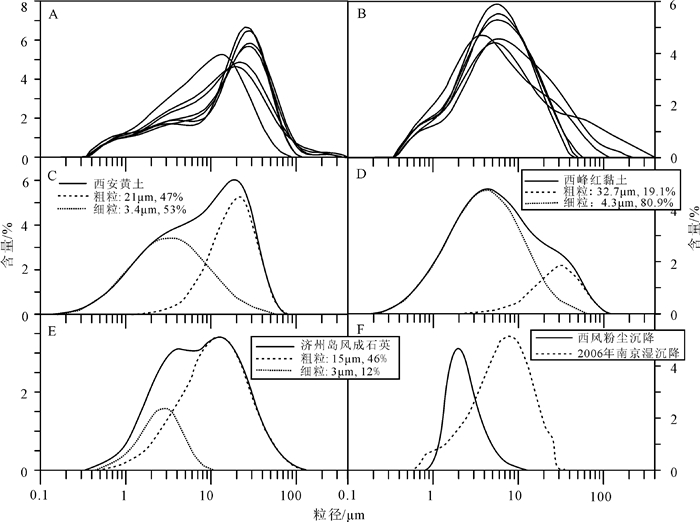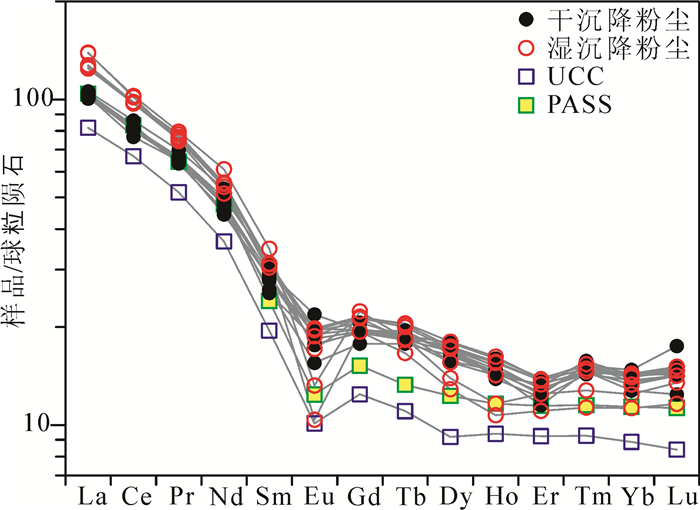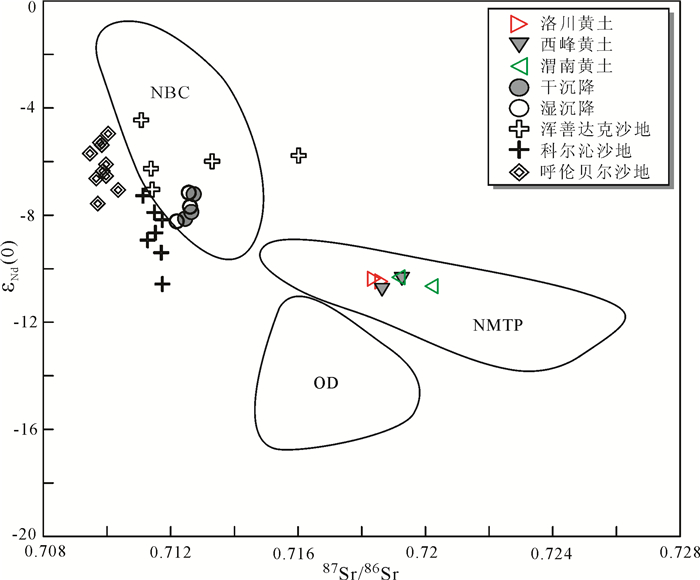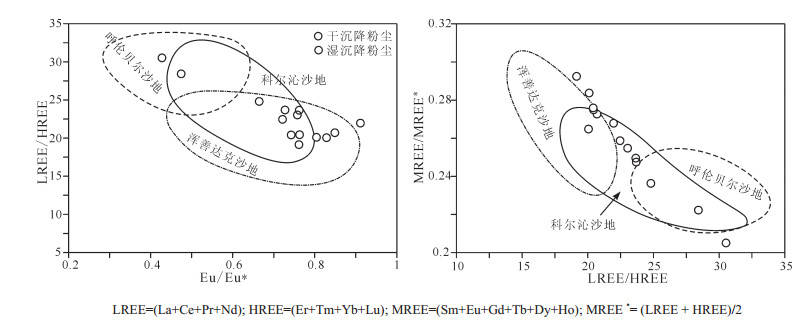Material characteristics of dust fallouts during the dust-storm weather in Harbin: Constraint on the provenance
-
摘要:
本文对哈尔滨尘暴事件(2011年5月11日)的干沉降和湿沉降粉尘进行了粒度、REE和Sr-Nd同位素组成分析。同时,为了限制尘暴粉尘的源区,还对东北沙地(科尔沁沙地和呼伦贝尔沙地)进行了表土采样。结果显示,干沉降粉尘呈双峰态粒度分布,众数值分别为3.6 μm和28 μm,而湿沉降呈单峰态粒度分布,众数值为6 μm。哈尔滨尘暴事件粉尘的粒度分布模式可与黄土高原黄土、红黏土及世界上其他地区的长距离搬运粉尘相对比。这些尘暴粉尘来自遥远的源区。干沉降和湿沉降粉尘表现出相同的REE模式和Sr-Nd同位素组成,它们来自科尔沁沙地和浑善达克沙地。现代尘暴事件的干沉降与湿沉降粉尘相同的物质来源暗示了黄土高原黄土的细颗粒和粗颗粒组分有相同的风尘源区。
Abstract:The dry- and wet-deposited dust depositions of the dust-storm event in Harbin on May 11, 2011 as well as the surface sediments from the potential sources were collected for investigation of grain-size, REE and Sr-Nd isotopic compositions. Some conclusions have been reached:The dry-deposited dusts are marked by bimodal grain-size distributions with fine mode at 3.6 μm and coarse mode at 28 μm whereas the wet-deposited dusts are indicative of unimodal grain-size modes with a fine mode at 6 μm. The grain-size modes for Harbin dust-storm dusts are compatible with CLP loess and Pliocene eolian red clay as well as the eolian dust entrained for a long distance in other regions of the world. These dust- storm depositions have a derivation from distinct sources. There are identical REE patterns and Sr-Nd isotopic compositions for dry- and wet-deposited dusts, suggestive of the derivation from Horqin Sandy Land and, to a certain extent, Onqin Daga Sandy Land. The corresponding Sr- Nd isotopic compositions for dry- and wet-deposited dusts give clues to suggest that fine grains in the CLP loess deposits are expected to be of derivation identical to coarse grains.
-
Key words:
- dust-storm depositions /
- loess /
- dust provenance /
- northeastern sandy land /
- material composition /
- fine particles
-

-
图 4 哈尔滨尘暴天气沉降物的Sr-Nd同位素组成及与东北风尘潜在源区、亚洲风尘潜在源区和黄土(Chen et al., 2007;Li et al., 2009a)的对比
Figure 4.
表 1 哈尔滨尘暴天气沉降物的REE含量(10-6)
Table 1. Concentrations of REE for Harbin dust-storm deposits (10-6)
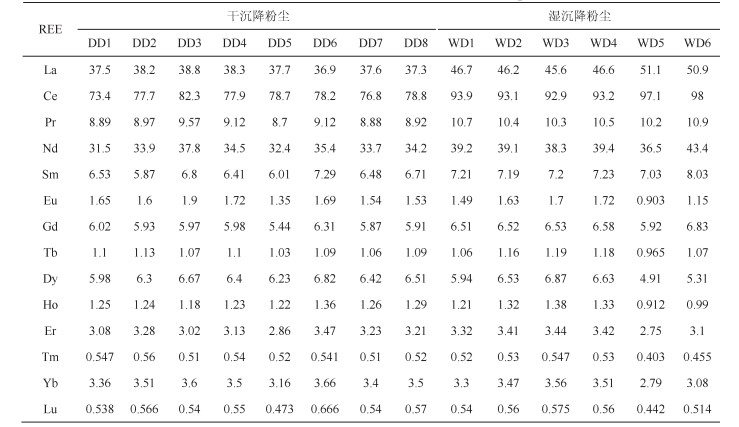
表 2 哈尔滨尘暴天气沉降物及潜在源区的Sr-Nd同位素组成
Table 2. Sr-Nd isotopic compositions for dust fallouts during Harbin dust-storm weather and potential sources

-
Absar N, Raza M, Roy M, Naqvi S M, Roy A K. 2009. Composition and weathering conditions of Paleoproterozoic upper crust of Bundelkhand craton, Central India:Records from geochemistry of clastic sediments of 1.9 Ga Gwalior Group[J]. Precambrian Research, 168:313-329. doi: 10.1016/j.precamres.2008.11.001
Ahmad I, Mondal M E A, Satyanarayanan M. 2016. Geochemistry of Archean metasedimentary rocks of the Aravalli craton, NW India:Implications for provenance, paleoweathering and supercontinent reconstruction[J]. Journal of Asian Earth Sciences, 126:58-73. doi: 10.1016/j.jseaes.2016.05.019
Amit R, Enzel Y, Mushkin A, Gillespie A, Batbaatar J, Crouvi O, Vandenberghe J, An Z S. 2014. Linking coarse silt production in Asian sand deserts and Quaternary accretion of the Chinese Loess Plateau[J]. Geology, 42(1):23-26. doi: 10.1130/G34857.1
An F Y, Ma H Z, Wei H C, Lai Z P. 2012. Distinguishing aeolian signature from lacustrine sediments of the Qaidam Basin in northeastern Qinghai-Tibetan Plateau and its palaeoclimatic implications[J]. Aeolian Research, 4:17-30. doi: 10.1016/j.aeolia.2011.12.004
An Z. 2000. The history and variability of the East Asian paleomonsoon climate[J]. Quaternary Science Reviews, 19:171-187. doi: 10.1016/S0277-3791(99)00060-8
An Z, Kukla G J, Porter S C, Xiao J. 1991. Magnetic susceptibility evidence of monsoon variation on the Loess Plateau of central China during the last 130, 000 years[J]. Quaternary Research, 36:29-36. doi: 10.1016/0033-5894(91)90015-W
Bhatia M R. 1985. Rare earth element geochemistry of Australian Paleozoic graywackes and mudrocks:Provenance and tectonic control[J]. Sedimentary Geology, 45:97-113. doi: 10.1016/0037-0738(85)90025-9
Bhatia M R, Crook K A W. 1986. Trace element characteristics of graywackes and tectonic setting discrimination of sedimentary basins[J]. Contributions to Mineralogy and Petrology, 92:181-193. doi: 10.1007/BF00375292
Che X D, Li G J. 2013. Binary source of loess on the Chinese Loess Plateau revealed by U-Pb ages of zircon[J]. Quaternary Research, 80:545-551. doi: 10.1016/j.yqres.2013.05.007
Chen J, Li G J, Yang J D, Rao W B, Lu H Y, Balsam W, Sun Y B, Ji J F. 2007. Nd and Sr isotopic characteristics of Chinese deserts:Implications for the provenances of Asian dust[J]. Geochimica et Cosmochimica Acta, 71:3904-3914. doi: 10.1016/j.gca.2007.04.033
Condie K C. 1991. Another look at rare earth elements in shales[J]. Geochimica et Cosmochimica Acta, 55:2527-2531. doi: 10.1016/0016-7037(91)90370-K
Crouvi O, Amit R, Enzel Y, Porat N, Sandler A. 2008. Sand dunes as a major proximal dust source for late Pleistocene loess in the Negev Desert, Israel[J]. Quaternary Research, 70:275-282. doi: 10.1016/j.yqres.2008.04.011
Crouvi O, Amit R, Enzel Y, Gillespie A R. 2010. Active sand seas and the formation of desert loess[J]. Quaternary Science Reviews, 29:2087-2098. doi: 10.1016/j.quascirev.2010.04.026
Crouvi O, Schepanski K, Amit R, Gillespie A R, Enzel Y. 2012. Multiple dust sources in the Sahara Desert:The importance of sand dunes[J]. Geophysical Research Letters, 39(13):L13401. http://onlinelibrary.wiley.com/doi/10.1029/2012GL052145/full
Derbyshire E, Meng X M, Kemp R A. 1998. Provenance, transport and characteristics of modern aeolian dust in western Gansu Province, China, and interpretation of the Quaternary loess record[J]. Journal of Arid Environments, 39:497-516. doi: 10.1006/jare.1997.0369
Enzel Y, Amit R, Crouvi O, Porat N. 2010. Abrasion-derived sediments under intensified winds at the latest Pleistocene leading edge of the advancing Sinai-Negev erg[J]. Quaternary Research, 74:121-131. doi: 10.1016/j.yqres.2010.04.002
Feng J L, Zhu L P, Ju J T, Zhou L P, Zhen X L, Zhang W, Gao S P. 2008. Heavy dust fall in Beijing, on April 16-17, 2006:Geochemical properties and indications of the dust provenance[J]. Geochemical Journal, 42:221-236. doi: 10.2343/geochemj.42.221
Gallet S, Jahn B, Torii M. 1996. Geochemical characterization of the Luochuan loess paleosol sequence, China, and paleoclimatic implications[J]. Chemical Geology, 133:67-88. doi: 10.1016/S0009-2541(96)00070-8
Gallet S, Jahn B M, Lanoe B V V, Dia A, Rossello E. 1998. Loess geochemistry and its implications for particle origin and composition of the upper continental crust[J]. Earth and Planetary Science Letters, 156:157-172. doi: 10.1016/S0012-821X(97)00218-5
Grousset F E, Biscaye P E. 2005. Tracing dust sources and transport patterns using Sr, Nd and Pb isotopes[J]. Chemical Geology, 222:149-167. doi: 10.1016/j.chemgeo.2005.05.006
Hao Q Z, Guo Z T, Qiao Y S, Xu B, Oldfield F. 2010. Geochemical evidence for the provenance of middle Pleistocene loess deposits in southern China[J]. Quaternary Science Reviews, 29:3317-3326. doi: 10.1016/j.quascirev.2010.08.004
Honda M, Yabuki S, Shimizu H. 2004. Geochemical and isotopic studies of aeolian sediments in China[J]. Sedimentology, 51(2):211-230. doi: 10.1111/sed.2004.51.issue-2
Jahn B, Gallet S, Han J M. 2001. Geochemistry of the Xining, Xifeng and Jixian sections, loess plateau of China:Eolian dust provenance and paleosol evolution during the last 140 ka[J]. Chemical Geology, 178:71-94. doi: 10.1016/S0009-2541(00)00430-7
Li G J, Chen J, Ji J F, Yang J D, Conway T M. 2009a. Natural and anthropogenic sources of East Asian dust[J]. Geology, 37(8):727-730. doi: 10.1130/G30031A.1
Li G J, Pettke T, Chen J. 2011. Increasing Nd isotopic ratio of Asian dust indicates progressive uplift of the north Tibetan Plateau since the middle Miocene[J]. Geology, 39(3):199-202. doi: 10.1130/G31734.1
Li Xusheng, Han Zhiyonng, Chen yingyong, Cai Yuanfeng, Yang Dayuan. 2009b. Characteristics and source of rain dust in Nanjing on March 11, 2006[J]. Quaternary Sciences, 29(1):43-54 (in Chinese with English abstract). http://www.wanfangdata.com.cn/details/detail.do?_type=perio&id=dsjyj200901005
Lim J and Matsumoto E. 2006. Bimodal grain-size distribution of aeolian quartz in a maar of Cheju Island, Korea, during the last 6500 years:Its flux variation and controlling factor[J]. Geophysical Research letters, 33. http://onlinelibrary.wiley.com/doi/10.1029/2006GL027432/pdf
Lim J and Matsumoto E. 2008a. Fine aeolian quartz records in Cheju Island, Korea, during the last 6500 years and pathway change of the westerlies over east Asia[J]. Journal of Geophysical Research Atmospheres, 113(D8):1-9. http://www.wanfangdata.com.cn/details/detail.do?_type=perio&id=4f5984057879aa37cee63780eac138b0
Lim J and Matsumoto E. 2008b. Estimation of aeolian dust flux on Cheju Island, Korea, during the Mid-to Late Holocene[J]. Quaternary International, s176-177(1):104-111. http://www.sciencedirect.com/science/article/pii/S1040618207000687
Liu C Q, Masuda A, Okada A, Yabuki S, Fan Z L. 1994. Isotope geochemistry of Quaternary deposits from the arid lands in northern China[J]. Earth and Planetary Science Letters, 127:25-38. doi: 10.1016/0012-821X(94)90195-3
Liu Z T, Yang X P. 2013. Geochemical-geomorphological evidence for the provenance of aeolian sands and sedimentary environments in the Hunshandake Sandy Land, eastern Inner Mongolia, China[J]. Acta Geologica Sinica, 87(3):871-884. doi: 10.1111/acgs.2013.87.issue-3
Maher B A, Mutch T J, Cunningham D. 2009. Magnetic and geochemical characteristics of Gobi Desert surface sediments:Implications for provenance of the Chinese Loess Plateau[J]. Geology, 37(3):279-282. doi: 10.1130/G25293A.1
McTainsh G H, Nickling W G, Lynch A W. 1997. Dust deposition and particle size in Mali, West Africa[J]. Catena, 29:307-322. doi: 10.1016/S0341-8162(96)00075-6
Nesbitt H W. 1979. Mobility and fractionation of rare earth elements during weathering of a granodiorite[J]. Nature, 279:206-210. doi: 10.1038/279206a0
Porter S C. 2001. Chinese loess record of monsoon climate during the last glacial-interglacial cycle[J]. Earth Science Reviews, 54:115-128. doi: 10.1016/S0012-8252(01)00043-5
Pullen A, Kapp P, McCallister A T, Chang H, Gehrels G E, Garzione C N, Heermance R V, Ding L. 2011. Qaidam basin and northern Tibetan Plateau as dust sources for the Chinese Loess Plateau and paleoclimatic implications[J]. Geology, 39(11):1031-1034. doi: 10.1130/G32296.1
Qiang M, Lang L, Wang Z. 2010. Do fine-grained components of loess indicate westerlies:Insights from observations of dust storm deposits at Lenghu (Qaidam Basin, China)[J]. Journal of Arid Environments, 74:1232-1239. doi: 10.1016/j.jaridenv.2010.06.002
Rea D K, Hovan S A. 1995. Grain size distribution and depositional processes of the mineral component of abyssal sediments:Lessons from the North Pacific[J]. Paleoceanography, 10(2):251-258. doi: 10.1029/94PA03355
Sun D H, An Z S, Su R X, Wu X H, Wang S M, Sun Q L. 2001. Mathematical approach to sedimentary component partitioning of polymodal sediments and its applications[J]. Progress in Natural Science, 11(5):374-382. http://www.wanfangdata.com.cn/details/detail.do?_type=perio&id=zrkxjz-e200105007
Sun D H, Bloemendal J, Rea D K, Vandenberghe J, Jiang F C, An Z S, Su R X. 2002. Grain-size distribution function of polymodal sediments in hydraulic and aeolian environments, and numerical partitioning of the sedimentary components[J]. Sedimentary Geology, 152:263-277. doi: 10.1016/S0037-0738(02)00082-9
Sun D H, An Z S, Su R X, Lu H Y, Sun Y B. 2003. Eolian sedimentary records for the evolution of monsoon and westerly circulations of northern China in the last 2.6 Ma[J]. Science in China (Series D), 46(10):1049-1059. doi: 10.1007/BF02959400
Sun D H. 2004. Monsoon and westerly circulation changes recorded in the late Cenozoic aeolian sequences of Northern China[J]. Global and Planetary Change, 41:63-80. doi: 10.1016/j.gloplacha.2003.11.001
Sun D H, Bloemendal J, Rea D K, An Z S, Vandenberghe J, Lu H Y, Su R X, Liu D S. 2004. Bimodal grain-size distribution of Chinese loess, and its palaeoclimatic implications[J]. Catena, 55:325-340. doi: 10.1016/S0341-8162(03)00109-7
Sun D H, Su R X, Bloemendal J, Lu, H Y. 2008a. Grain-size and accumulation rate records from Late Cenozoic aeolian sequences in northern China:Implications for variations in the East Asian winter monsoon and westerly atmospheric circulation[J]. Paleogeography, Paleoclimatology, Palaeoecology, 264:39-53. doi: 10.1016/j.palaeo.2008.03.011
Sun Y B, Tada R, Chen J, Liu Q S, Toyoda S, Tani A, Ji J F, Isozaki Y. 2008b. Tracing the provenance of fine-grained dust deposited on the central Chinese Loess Plateau[J]. Geophysical Research Letters, 35, L01804. http://www.wanfangdata.com.cn/details/detail.do?_type=perio&id=0e57c1231fa9ea1f65860f07f2dcdbbb
Taylor S R and McLennan S M. 1985. The Continental Crust:Its Composition and Evolution[M]. London:Oxford Blackwell, 1-312.
Tsoar H, Pye K. 1987. Dust transport and the question of desert loess formation[J]. Sedimentology, 34:139-153. doi: 10.1111/sed.1987.34.issue-1
Xie Yuanyun, He Kui, Kang Chunguo. 2005. Grain-size distribution of fall-outs of an exceedingly large dust storm in Harbin City and its implications[J]. Geology in China, 32(3):502-506 (in Chinese with English abstract). http://www.wanfangdata.com.cn/details/detail.do?_type=perio&id=zgdizhi200503021
Xie Yuanyun, Meng Jie, Guo Lingfen, He Kui. 2013. REE geochemistry for sand-dust fallouts in Harbin, Heilongjiang province and provenance analysis[J]. Earth Science——Journal of China University of Geosciences, 38(5):923-933 (in Chinese with English abstract). doi: 10.3799/dqkx.2013.091
Yan Y, Sun Y B, Ma L, Long X. 2015. A multidisciplinary approach to trace Asian dust storms from source to sink[J]. Atmospheric Environment, 105:43-52. doi: 10.1016/j.atmosenv.2015.01.039
Yang J D, Li G J, Rao W B, Ji J F. 2009. Isotopic evidences for provenance of East Asian Dust[J]. Atmospheric Environment, 43:4481-4490. doi: 10.1016/j.atmosenv.2009.06.035
Yin Zhiqiang, Qin Xiaoguang, Li Yumei, Ning Bo. 2008. Influence of the dust source distance on the multimodal grain-size distribution characteristics of loess[J]. Geology in China, 35(5):1037-1044 (in Chinese with English abstract). http://www.wanfangdata.com.cn/details/detail.do?_type=perio&id=zgdizhi200805023
李徐生, 韩志勇, 陈英勇, 蔡元峰, 杨达源. 2009. 2006年3月11日南京"泥雨"降尘特征及其粉尘来源[J].第四纪研究, 29(1):43-54. http://www.wanfangdata.com.cn/details/detail.do?_type=perio&id=dsjyj200901005
谢远云, 何葵, 康春国. 2005.哈尔滨市特大沙尘暴沉降物的粒度分布及意义[J].中国地质, 32(3):502-506. doi: 10.3969/j.issn.1000-3657.2005.03.021 http://geochina.cgs.gov.cn/geochina/ch/reader/view_abstract.aspx?file_no=20050321&flag=1
谢远云, 孟杰, 郭令芬, 何葵. 2013.哈尔滨沙尘沉降物稀土元素地球化学特征及其物源分析[J].地球科学, 38(5):923-933. http://d.old.wanfangdata.com.cn/Periodical/dqkx201305003
殷志强, 秦小光, 李玉梅, 宁波. 2008.源区距离对黄土粒度多组分分布特征的影响[J].中国地质, 35(5):1037-1044. doi: 10.3969/j.issn.1000-3657.2008.05.023 http://geochina.cgs.gov.cn/geochina/ch/reader/view_abstract.aspx?file_no=20080523&flag=1
-



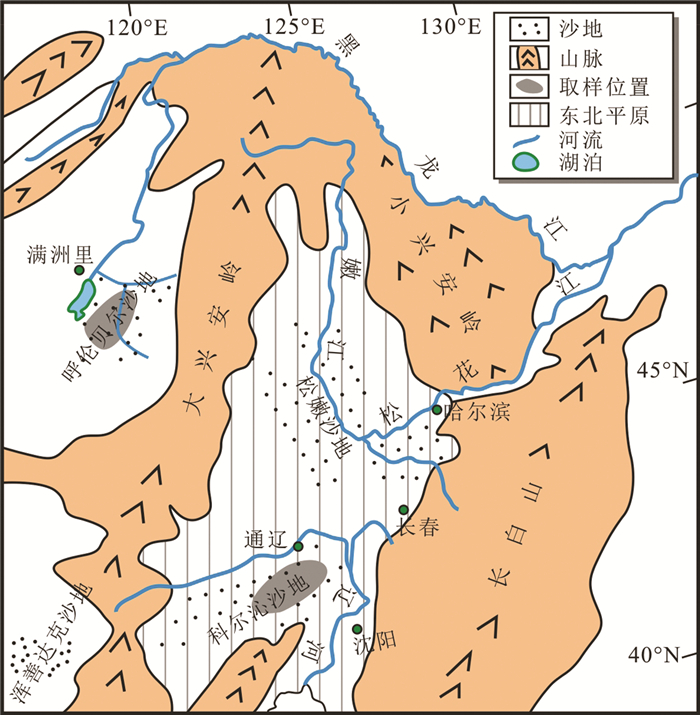
 下载:
下载:
